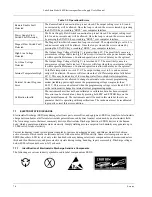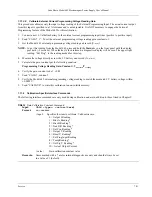
Lake Shore Model 642 Electromagnet Power Supply User’s Manual
7-6
Service
Table 7-3. Operational Errors
Remote Enable Fault
Detected
The Remote Enable connection loop is not closed. The output setting is set to 0 A and
no current entry will be allowed. Once the loop is closed, the error is cleared by pressing
the STATUS key or sending “ERCL” over computer interface.
Power Supply Flow
Switch Fault Detected
The Power Supply Flow Switch connection loop is not closed. The output setting is set
to 0 A and no current entry will be allowed. Once the loop is closed, the error is cleared
by pressing the STATUS key or sending “ERCL” over computer interface.
Magnet Flow Switch Fault
Detected
The Magnet Flow Switch connection loop is not closed. The output setting is set to 0 A
and no current entry will be allowed. Once the loop is closed, the error is cleared by
pressing the STATUS key or sending “ERCL” over computer interface.
High Line Voltage
Detected
The Output Stage Voltage (Out Stg V) is greater than 66 V. The most likely cause is a
power mains voltage that is too high. This error will clear when the power mains voltage
is within specified tolerances. Continued operation is allowed but may not be optimal.
Low Line Voltage
Detected
The Output Stage Voltage (Out Stg V) is less than 44 V. The most likely cause is a
power mains voltage that is too low. This error will clear when the power mains voltage
is within specified tolerances. Continued operation is allowed but may not be optimal.
Internal Temperature High
Cold Plate temperature is over 40° C. The output setting is set to 0 A and no current
entry will be allowed. The error will clear when the Cold Plate temperature falls below
40° C. This may be indicative of low cooling water flow or high water temperature.
External Current Program
Error
The instrument was not allowed to change to external or sum current programming
modes (including power-up) because the programming voltage was greater than
0.025 V. This error can be cleared when the programming voltage is less than 0.025 V
or the instrument is changed to internal current programming mode.
Calibration Invalid
The instrument has either not been calibrated or calibration data has been corrupted.
This error can be cleared at any time by pressing both ESC and ENTER keys on the
keypad simultaneously. The instrument can still be used in this state but there is no
guarantee that it is operating within specifications. The instrument must be recalibrated
to properly correct this error condition.
7.7 ELECTROSTATIC
DISCHARGE
Electrostatic Discharge (ESD) may damage electronic parts, assemblies, and equipment. ESD is a transfer of electrostatic
charge between bodies at different electrostatic potentials caused by direct contact or induced by an electrostatic field.
The low-energy source that most commonly destroys Electrostatic Discharge Sensitive (ESDS) devices is the human
body, which generates and retains static electricity. Simply walking across a carpet in low humidity may generate up to
35,000 volts of static electricity.
Current technology trends toward greater complexity, increased packaging density, and thinner dielectrics between
active elements, which results in electronic devices with even more ESD sensitivity. Some electronic parts are more
ESDS than others. ESD levels of only a few hundred volts may damage electronic components such as semiconductors,
thick and thin film resistors, and piezoelectric crystals during testing, handling, repair, or assembly. Discharge voltages
below 4000 volts cannot be seen, felt, or heard.
7.7.1
Identification of Electrostatic Discharge Sensitive Components
The following are various industry symbols used to label components as ESDS.
















































